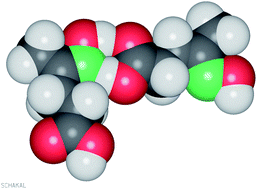Structure and energy in organic crystals with two molecules in the asymmetric unit: causality or chance?†
Abstract
The structures of 5547 organic crystals with two molecules in the asymmetric unit (Z′ = 2) are collected from the Cambridge Structural Database, and compared with a sample of 45182 crystal structures with one molecule in the asymmetric unit (Z′ = 1). A new method for standardizing H-atom positions is described. Approximate symmetry in Z′ = 2 crystals is analyzed using real-space information only. Lattice energies are calculated by the PIXEL method and partitioned into contributions from the two different sites in Z′ = 2 crystals and into molecule–molecule contributions, with special attention paid to the most energetic molecular pair. There are no obvious differences between the Z′ = 1 and Z′ = 2 sets in chemical composition, except for a slightly smaller average size of Z′ = 2 molecules. The frequency of space groupsP1, P21 and P![[1 with combining macron]](https://www.rsc.org/images/entities/char_0031_0304.gif) increases in Z′ = 2 crystals, while the frequency of space groupsP21/c and P212121 decreases. 83% of the Z′ = 2 crystals show some form of pseudosymmetry with a tolerance of 0.5 Å atom−1. The most energetic pair is on average more tightly bound in Z′ = 2 crystals than in Z′ = 1 crystals, and in Z′ = 2 crystals the asymmetric pair ranks first in the list of molecule–molecule energies in 55–60% of the cases. However, even in crystals where the asymmetric pair is the most energetic, its contribution to the total lattice energy can be as high as 70% or as low as 10%: in many cases, the asymmetry is between weakly interacting molecules. Structural molecular features leading to Z′ = 2 crystals are tentatively analyzed. On the whole, there appears to be a continuum of situations from asymmetric pairs formed between clearly different molecules that pack in clearly different environments (hinting at causality of Z′ = 2) and pairs formed by nearly identical molecules packing in nearly identical environments (hinting at casual, local conditions), but even in the latter case, there is no proof that a fully symmetric structure would be more stable.
increases in Z′ = 2 crystals, while the frequency of space groupsP21/c and P212121 decreases. 83% of the Z′ = 2 crystals show some form of pseudosymmetry with a tolerance of 0.5 Å atom−1. The most energetic pair is on average more tightly bound in Z′ = 2 crystals than in Z′ = 1 crystals, and in Z′ = 2 crystals the asymmetric pair ranks first in the list of molecule–molecule energies in 55–60% of the cases. However, even in crystals where the asymmetric pair is the most energetic, its contribution to the total lattice energy can be as high as 70% or as low as 10%: in many cases, the asymmetry is between weakly interacting molecules. Structural molecular features leading to Z′ = 2 crystals are tentatively analyzed. On the whole, there appears to be a continuum of situations from asymmetric pairs formed between clearly different molecules that pack in clearly different environments (hinting at causality of Z′ = 2) and pairs formed by nearly identical molecules packing in nearly identical environments (hinting at casual, local conditions), but even in the latter case, there is no proof that a fully symmetric structure would be more stable.

- This article is part of the themed collection: Computational contributions to crystal engineering

 Please wait while we load your content...
Please wait while we load your content...